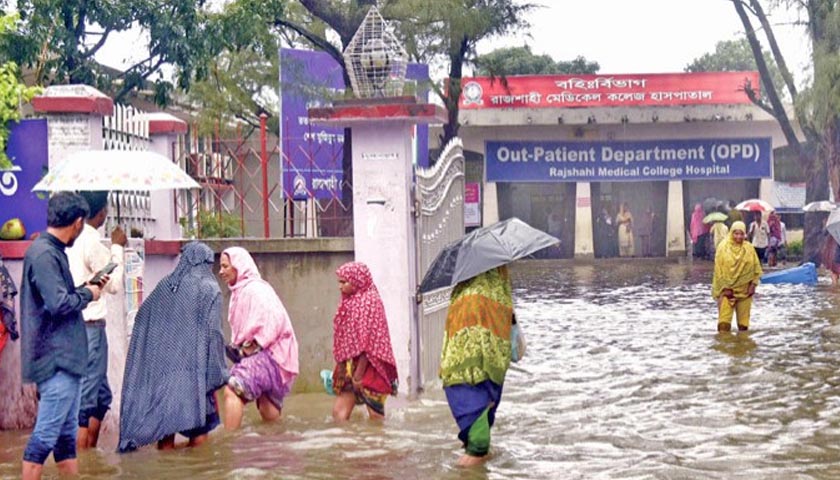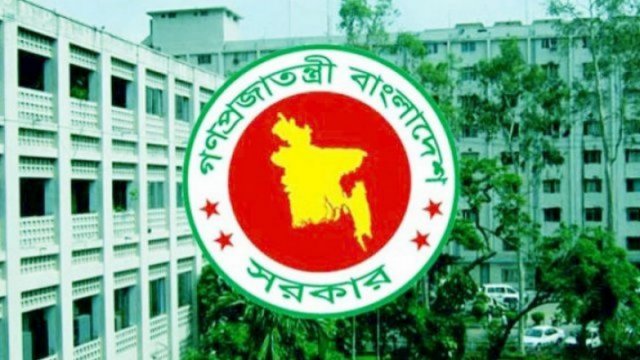Heavy rain amid a surge of water from upstream India has left swathes of northern Bangladesh flooded, including Rajshahi city, causing damage and suffering to life and property.
While the city people faced serious troubles with streets submerged in waist-deep water following record rain, people along the Teesta basin in five other northern districts were forced to seek temporary shelter away from home or remained stranded in the flash flood triggered by the onrush of water from India on Thursday.
In the 24 hours until 6:00 pm on Thursday, Rajshahi received 244mm, the highest amount of rain recorded in the city in the past 10 years, according to meteorologist Rahidul Islam.
About 100 spots in Rajshahi city were flooded, prompting people to use boats for emergency communication.
Authorities suspended academic activities and scheduled examinations for Thursday due to the flooding, which also brought many to the streets with nets to catch fish from washed-away farms.
The flash flood washed away 73 houses while temporarily displacing 33,000 people and leaving 30,000 families stranded in the five districts in Rangpur division, authorities said.
At least two bodies of unidentified men, one of them dressed in an Indian army uniform, were recovered in Lalmonirhat and Rangpur on Thursday morning, with the Teesta River flowing above its danger mark at Kaunia, Rangpur, and other major rivers rapidly swelling.
Parts of Bangladesh and its adjacent upstream areas in India are under extreme rainfall watch today as low pressure continues to hover over the area, threatening to dump more water.
The flash flood believed to be triggered by cloudbursts over Lhonak Lake in north Sikkim, washed away the Indian state’s biggest hydroelectric dam, causing severe damage to life and property downstream.

At least 22 army members are among the over 100 people missing since the flash flood hit upstream areas in the early hours of Wednesday, roughly 300 km from Bangladesh.
‘The body of a young man in an Indian army uniform was recovered from the Thalapak char on Thursday morning,’ said Dulal Mia, officer-in-charge of the Gangachara police station in Rangpur.
Lalmonirhat’s Hatibandha police station’s officer-in-charge, Shah Alam, said another body was recovered near the Teesta barrage in Bangladesh on Thursday morning.
The flash flood washed away a 300-foot-long embankment in Gangachara, washing away 11 houses in Paschim Isli village in the morning, according to the local office of the Water Development Board.
Another embankment was washed away in Rajarhat, Kurigram, by the onrush of water from upstream.
‘At least 30,000 people living in low-lying areas of five northern districts have become stranded in flood waters,’ said WDB superintendent engineer Ahsan Habib.
The flood-affected districts are Lalmonirhat, Kurigram, Rangpur, Gaibandha, and Nilphamari.
The Teesta was flowing 30cm above the danger mark at Kaunia, Rangpur, at 3:00pm on Thursday.
‘We left all of a sudden, leaving everything behind. God knows when we will be able to get back home,’ said Jaitun Nahar, a resident of Mohishkhocha who took shelter in Balapara madrassah.
This has been the ninth time that the water level at Dalia has crossed the danger limit since June, each time because of the arbitrary release of water through the Gajaldoba barrage by India.
The water level in Teesta at Dalia dropped below the danger mark on Thursday, hours after the river flowed 25cm above the danger mark on Wednesday night.
‘The Teesta rose over 3 feet in 10 hours since Wednesday morning,’ said Khairul Islam, superintending engineer, Hydrology Division, WDB.
On Wednesday morning, the flow in the Teesta was recorded to be over 55,000 cusec, he said, adding that the Teesta flow peaked at Dalia between 7:00pm and 8:00pm.
Asfa-Ud-Doula, executive engineer, WDB, at Teesta Barrage’s Dalia Zone, said the Teesta flow was recorded to be 86,000 cusec between 7:30pm and 8:30pm.
The rapid swelling of the Teesta has caused 33,000 people to move to shelters, the Rangpur divisional commissioner’s office estimated.
Indian media, citing the Central Water Commission, reported that the size of the glacier lake, Lhonak Lake, was reduced by 100 hectares after it burst, causing the flash flood.
Biswajit Nath, who teaches geography and environmental studies at the University of Chittagong, said that the lake has witnessed several events of extreme precipitation since July, leading to the glacial lake outburst flood.
The Flood Forecasting and Warning Centre, in a bulletin issued on Thursday afternoon, predicted a rapid rise in the rivers Dharla, the Dudhkumar, the Upper Karatoa, the Upper Atrai, the Punarvaba, the Kulikh, the Tangon, the Isamoti Jamuna, and the Jamuneswari over the next 48 hours because of heavy rain.
The BMD reported over 100mm of rain in the 24 hours until 6:00pm on Thursday in Khepupara, Bhola, Chuadanga, Kumarkhali, Netrakona, Tarash, Ishwardi, Tangail, and Faridpur.
In a bulletin issued at 6:00pm on Thursday, the Bangladesh Meteorological Department said that the low pressure over the Gangetic West Bengal and western Bangladesh might cause rain in most areas of five divisions, including Dhaka, over the next 24 hours.
The heavy rainfall might cause a landslide in the Chattogram division, the BMD said in a warning.
The maritime ports have been asked to hoist signal number three until further notice, and fishing boats have been asked to stay close to the shore because of deep convection due to a strong monsoon in the north Bay of Bengal.source: newage



